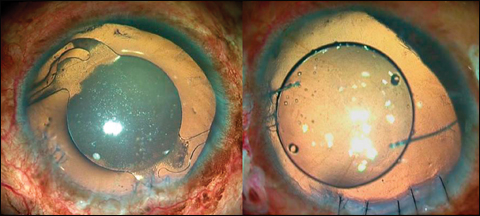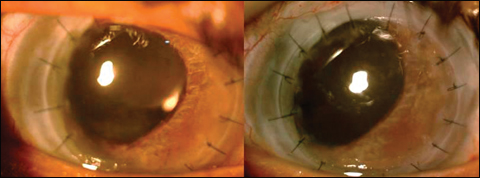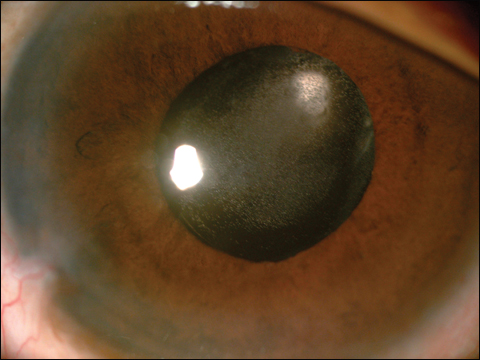IOL surface alterations uncommon but troublesome
The physical nature of an IOL depends mainly on the material it is made up of. Although surface changes on the lens capsule can manifest as capsular opacification, as often noted after cataract surgery, IOL surface changes are not common. Optic abrasions, pigment dispersion, discoloration and opacification are the possible surface changes that can happen in the optic. An optic of 3 mm to 4 mm covers the pupillary zone in a normal anatomical situation, and surface abnormalities in this zone risk disturbing the patient’s best corrected vision. Optic opacification has been reported in various lens materials, including silicone and hydrophilic acrylic. In this column, we will highlight some of our interesting cases of IOL surface abnormalities, discoloration and opacification, and their method of management in concomitant ocular comorbidity.
Etiology
Water vapor can be absorbed into IOL material, especially hydrogel, causing discoloration of the optic. Small fluid-filled vacuoles within the optic of the IOL may be due to a change in the immediate micro-environmental temperature. Calcium deposition and subsequent opacification have been shown in hydrophilic lenses. Silicone oil-filled eyes undergoing cataract surgery with IOL implantation run the risk of adhesion of silicone oil to the IOL surface, especially to silicone optic IOL designs. Interface or interlenticular opacification can happen in piggyback lenses.
Opacified lens in silicone oil-filled eye
A 45-year-old male patient who underwent vitreoretinal surgery and silicone oil infusion with a scleral-fixated lens for post-traumatic retinal detachment with lens damage came to us with progressive loss of vision in the operated eye for the last 3 months. On examination, the scleral-fixated IOL optic was opacified (Figure 1). The posterior segment examination showed a silicone oil-filled eye with an attached retina. The patient underwent silicone oil removal with opacified IOL explantation and glued IOL implantation in the same sitting. Postoperatively, the glued IOL was stable and retained its transparency.

Images: Agarwal A


Post-uveitis IOL discoloration
Recurrent inflammation due to repeated air injection into the anterior chamber can induce IOL opacification. A 56-year-old female patient who had Descemet’s detachment after cataract surgery underwent air injection twice. She had immediate postoperative severe anterior chamber reaction that resolved with steroid treatment. Although her Descemet’s was attached after air injection, she experienced progressive visual loss after a few years. On examination, there was an opacified IOL in the central optic zone exposed to air. There was posterior synechiae and pigment release, indicating old uveal inflammation. Her best corrected visual acuity was reduced to 20/80 from 20/20. IOL exchange was performed.
Chronic pigment dispersion in an inflamed eye can also produce dense pigment deposition on the anterior IOL surface, leading to discoloration. This is often removed by pigmentolysis after the control of inflammation with steroids. However, one of our patient IOL explantations was performed due to persistent uveal inflammation. Digital light microscopy and phase contrast microscopy of the explanted IOL showed pigment adherence as granular deposits, multiple water vacuoles and fern pattern crystals (Figure 2).
IOL opacities after intracameral gas injection
Intracameral isoexpansile gases such as C3F8 and SF6 injection have been used for post-endothelial keratoplasty graft adherence. A 56-year-old patient who underwent penetrating keratoplasty developed progressive loss of vision due to IOL opacification. IOL exchange was performed under steroid coverage (Figure 3). Intraoperative manipulation has to be minimized in such eyes in which the IOL exchange is performed under donor cornea. The postoperative inflammation has to be controlled with systemic steroids. A 40-year-old patient who underwent endothelial keratoplasty came with progressive vision loss after 6 months. There was a history of immediate graft detachment and intracameral gas (SF6) injection. On examination, there was central dispersed IOL opacification with clear annulus (Figure 4). His BCVA was 20/40, so the patient was refracted with glasses and kept under follow-up observations.


Surface microabrasions in iris-fixated lens
Intraoperative injury while implanting the IOL can lead to surface scratches and abrasions. Severe surface changes can affect the quality of vision. A 35-year-old patient with a history of previous cataract surgery in early childhood came to us with complaints of poor visual quality. On examination, he had bilateral iris-fixated IOLs with the optic surfaces showing scratches and abrasions. His BCVA improved by one line in both eyes after IOL exchange with the glued IOL method (Figure 5).
Precautions and complications
IOL exchange is the accepted choice of management in all these cases. However, the predisposing conditions — inflammation, water content of lenses and intracameral gas — need to be avoided in the future in high-risk patients. Because complications in many of these eyes occur over the long term, explantation can induce zonular dehiscence or capsular bag damage. The surgeon should thus be prepared for this scenario and be skilled in IOL implantation in deficient capsules. Avoiding silicone IOLs in those eyes with a predisposition for vitreoretinal surgeries with silicone oil and preoperative assessment of water content of IOLs in eyes that require endothelial keratoplasty can be practiced. Patients with the risk factor of previous recurrent uveitis due to multiple surgical interventions also need care. Implanting heparin-coated or modified IOLs in eyes with previous uveitis can decrease the deposition of pigment matrix on the lenses postoperatively. Central small opacification or sparse dispersed lens opacity with a surrounding clear zone can be corrected with refraction and followed up with observation. However, the quality of vision through the fogged IOL optic will always affect the clarity of the potential best vision.
- References:
- Apple DJ, et al. Ophthalmology. 1996;doi:10.1016/S0161-6420(96)30463-6.
- Eleftheriadis H, et al. Br J Ophthalmol. 2001;doi:10.1136/bjo.85.7.830.
- Foot L, et al. Am J Ophthalmol. 2004;doi:10.1016/j.ajo.2003.12.047.
- Neuhann IM, et al. Cornea. 2013;doi:10.1097/ICO.0b013e31826150de.
- Pandey SK, et al. Arch Ophthalmol. 2001;120(3):391-393.
- Werner L. J Cataract Refract Surg. 2007;doi:10.1016/j.jcrs.2007.01.015.
- Werner L, et al. J Cataract Refract Surg. 2006;doi:10.1016/j.jcrs.2005.12.137.
- Werner L, et al. J Cataract Refract Surg. 2012;doi:10.1016/j/jcrs.2012.01.012.
- For more information:
- Amar Agarwal, MS, FRCS, FRCOphth, is director of Dr. Agarwal’s Eye Hospital and Eye Research Centre. Agarwal is the author of several books published by SLACK Incorporated, publisher of Ocular Surgery News, including Phaco Nightmares: Conquering Cataract Catastrophes, Bimanual Phaco: Mastering the Phakonit/MICS Technique, Dry Eye: A Practical Guide to Ocular Surface Disorders and Stem Cell Surgery and Presbyopia: A Surgical Textbook. He can be reached at 19 Cathedral Road, Chennai 600 086, India; email: dragarwal@vsnl.com; website: www.dragarwal.com.
Disclosure: No products or companies that would require financial disclosure are mentioned in this article.
